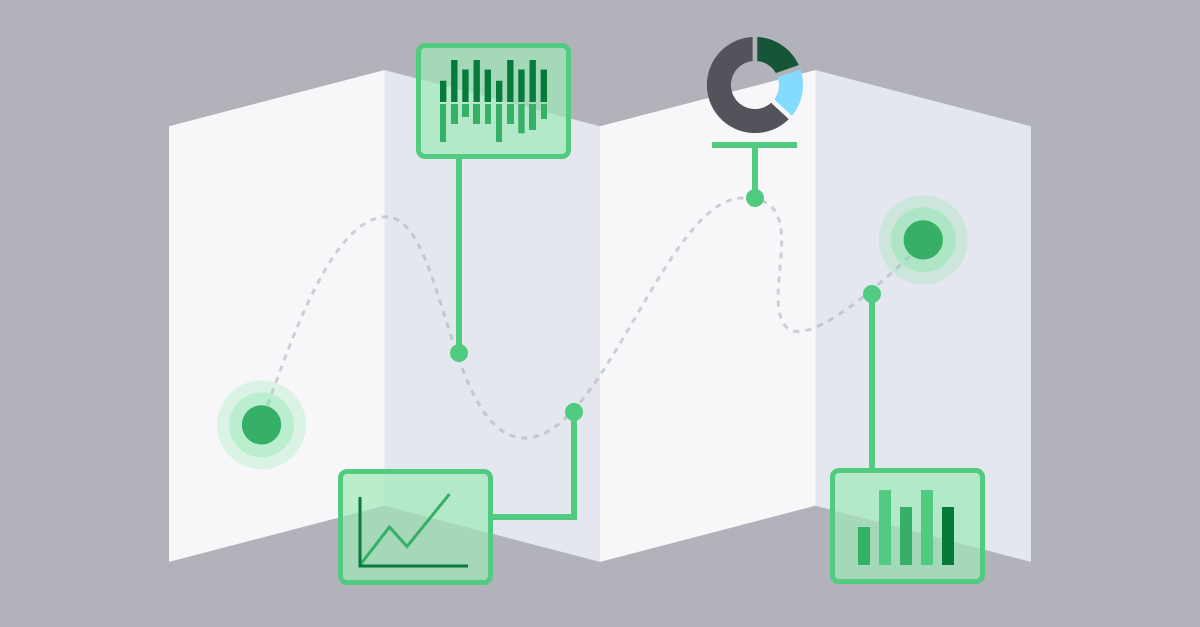How to Become a Data-Driven Company
Justin Reynolds, Data specialist
August 29, 2022
NaN minute read

Just about every business leader today wants to build a data-driven company. Pitch decks are stacked full with promises of AI and machine learning, real-time data, and intelligent insights, with companies investing millions into tools and data initiatives designed to add value.
But what does it really mean to be data-driven? And how can companies balance data capabilities and cost as they build out innovative data solutions?
What is a data-driven organization?
A data-driven organization invests in modern BI, data infrastructure, and self-service tools so that everyone can make business decisions based on reliable, standardized information. Data-driven companies must be able to connect all of their data sources on one platform, build flexible reporting and dashboards, and get the whole company excited about collaborative, ubiquitous data workflows.
What are the attributes of data-driven companies?
At data-driven companies, leadership and employees view data as a critical asset that’s worth investing in. Data-driven companies also:
educate on the importance of data-driven decisions
strive for data democratization
embrace a culture of data exploration
have company-wide policies and guardrails in place that ensure accuracy and governance
provide tools that both analysts and non-analysts can use to find answers to important business questions.
What does a data-driven business look like?
You can look at a company’s data stack, policies, and analytics workflows to understand where they are in terms of becoming fully data-driven. One way to assess this is by benchmarking against the Mode data maturity model—take a look at the five stages below to see where you fall.
The stages of data maturity for businesses
1. Patchwork analytics
You don’t have an official data team, analytics is decentralized, and you’re working with a patchwork of tools and data sources. In this phase, each department assesses their own data and tries to connect the data stories through exports from tools like Salesforce and Marketo, or even just using spreadsheets. However, you manage reporting on basic metrics, even it creates a backlog for the few analysts who can field questions from business teams.
A larger company-wide data strategy and culture is on the wishlist, but won’t be a reality until department heads can work from a single source of truth. This means leadership still leans heavily on instinct over data, which is hard to scale.
2. Departmental analytics
At this stage, you still haven’t built a centralized data team, but do have a data analyst dedicated to major business functions. Different teams have invested in data to different degrees, with some using a data warehouse and ETL tools and others still relying on practices from stage one. In this case, the departments without strong analytics tools suffer, as do execs who are still making decisions based on partial information.
If you’re stuck at this stage, you can level the playing field by connecting each department’s data into a single warehouse and examining it in a BI platform like Mode. Even if you’re missing important metrics, you’ll be confident that what you have is normalized, accurate, and up-to-date.
To forge ahead to the next stage, check out our webinar Small Team, Big Impact for insights from early-stage leaders at Notion, YCombinator, and others on the role data plays in driving growth.
3. Reactive analytics
In this stage, you’ve centralized data collection, transformation, and management with an enterprise-wide BI solution (great!) but analytics aren’t yet accessible to everyone (not great). Your data team is still bogged down by a large volume of requests from different business users who wish they could just look up the answers themselves.
When you’re busy building reports and dashboards but still feel underwater, try pausing and working out the top KPIs each team cares about the most. Instead of going through the backlog by when a request was made, prioritize by impact and build a few great dashboards that business stakeholders can get used to checking regularly.
To build the most useful dashboards for non-analysts and start reducing the backlog for good, read our post on KPI reporting and metrics tracking. Your next step will be creating self-service tools for your business users, so start thinking about governance, security, and how to limit compute overages as you let more of your colleagues analyze data their own way.
4. Proactive analytics
Your company has now developed much more of a data-driven culture, with a central source of truth but decentralized strategy for getting questions answered. The data team has time and energy to proactively seek out opportunities for data innovation, while non-analysts take it upon themselves to analyze data using self-serve tools. Data team members and business stakeholders collaborate often, predictive analytics are in play, and the culture encourages viewing data as a product rather than just a performance-tracking tool.
5. Democratized analytics
As the holy grail of data-driven companies, an organization at this stage uses data to inform nearly all decisions. The majority of domain experts are also citizen analysts, and are active in ongoing experiments to uncover more value from company data. There’s a clear process for when and how data teams should invest in data applications, and the company culture is completely intertwined with data—every crucial decision is data-driven.
Today, reaching this level opens up a world of opportunities to embrace the latest in AI, machine learning, and automation. It’s easy to connect new tools, collaborate on sophisticated models, and make on-the-fly observations based on real-time event or product behavioral data.
Download

A Data Maturity Assessment
See where your team falls on our data maturity assessment.
How to become a data-driven organization
Before you do anything, it’s a good idea to make sure your team is ready to embrace data at the next stage. You’ll want to have buy-in from your stakeholders on investing in a data analytics solution that works for your company’s goals and structure. Once you get the go-ahead, it’s time to invest in a platform that can deliver value quickly.
1. Connect your disparate data on one platform
The first step is building a pipeline for your data. Mode was made to bring data sources together quickly—integrate data from each business function, like marketing, sales, and customer support.
Believe it or not, you can build and deploy a complete data stack in just 30 minutes or less, regardless of how big your company is. Once data is connected and analysts can start exploring, you can deliver rapid impact, which can go a long way toward driving cultural change and convincing key stakeholders to trust and utilize data in their daily operations.
2. Establish key metrics to guide the company’s strategy
To become data-driven, Stancil recommends companies focus on key analytics — or north star metrics — to separate truth from opinions and make objective, reasoned business decisions. This, Stancil says, is more important than focusing on generating revenue or padding the bottom line.
There are some specific conditions that are necessary to make this happen. For example, key metrics need to be singular.
“Companies can’t chase dozens of performance indicators, with each team having their own preferred set,” Stancil writes. “If they do, everyone ends up confused; at worst, people proxy their opinions through weaponized KPIs. This doesn’t end arguments; it escalates them.”
What’s more, metrics also have to be achievable, and they have to endure. In other words, you shouldn’t be changing key metrics regularly. Instead, as Stancil points out, the metrics you’re optimizing need to point to the spot where you want to be on the horizon.
Metrics Definition Template
Use this template to define metrics with stakeholders.
3. Break down silos and democratize data
When data is democratized, everyone can benefit from it without the need for a specialized data science skillset. To become data-driven, companies must actively work to break down data silos and provide teams with shared definitions and clean data sets. The end goal should be complete data democratization, where everyone in the organization can feel comfortable gleaning insights from different data sources and using them to make better decisions.
4. Make reports easy to read
Most employees today have limited skills when it comes to analyzing and interpreting data. According to a recent Harvard Business Review article, just 25% of workers feel confident in their data skills. For this reason, it helps to optimize reports by making them visually appealing and easy to read. By doing so, people can explore them with confidence regardless of their skills and experience. Clear visualization makes it easier for non-technical teams to understand data and know how to apply it to their initiatives.
"Clear visualization makes it easier for non-technical teams to understand data and know how to applies to their intiatives."
Making reports easy to access and use can also help improve data literacy. The more employees interact with data, the more comfortable they will become using it and relying on it to make decisions.
5. Encourage data-driven meetings
Another great way to become more data-driven is to provide cross-functional, data-driven updates with different teams. This could take the form of weekly office hours or bi-weekly meeting with the data team. Including the data team gives employees the chance to get the most context for their data question. It also provides continuous improvement for data literacy.
6. Use interactive data dashboards
Many companies have had success by using interactive reports and dashboards that enable employees to access and interact with data in a place that’s secure and user-friendly. Another name for this is data exploration. When business stakeholders can explore the data without affecting the underlying report, they can get answers on their own without having to wait for the data team. Mode dashboards makes it easy for any teammate to analyze and visualize data to get answers in one platform with our Explorations feature.
Becoming data-driven takes time
Organizations can’t become data-driven overnight. It takes substantial resources and buy-in to get from stage one to five, but doing it will pay off in dividends.
As Mode Co-founder and Chief Analyst, Benn Stancil, explains in a recent blog post, being data-driven is a long game, and it takes time to accumulate an advantage. Business value comes from putting in the effort of accumulating small wins, which add up over time.
To move toward becoming a truly data-driven company faster, you should choose software and partners that have data built into their DNA.
What are the benefits of becoming a data-driven business?
When you can confidently make decisions based on your company’s data, you’ll more easily forecast the future, measure and improve performance, and uncover critical insights about the organization—sometimes ones you weren’t even looking for.
1. You know when to pivot or double down - Being data-driven gives executives and managers the facts to support their decisions, reducing risk and making it easier to know when to pivot or double down.
2. You can begin to build a culture of data literacy - Because data-driven businesses establish a culture of data literacy, they talk about metrics early and often. Everyone feels a sense of accountability are more self-sufficient when they need quick answers.
3. Make better choices, faster than your competitors - Finally, data-driven businesses just make better choices. Armed with a constant flow of information about their company and customers (plus technology to keep up with and interpret it), these companies move faster and more confidently than their competitors.
4. Identifying financial risks before they arise - Data can be helpful for identifying and mitigating financial risks. For example, streaming companies use predictive analytics to anticipate when users are likely to cancel a subscription. By adjusting the customer experience or sending special offers, they may be able to avoid churn.
Mode for Data Exploration

Mode for Self-Serve
Learn how Mode helps business teams explore data confidently. Discover how to turn your data into a true competitive advantage.
How can Mode help your company become data-driven?
At Mode, our philosophy is that analysis is only as good as the decisions that are made with it. Here at Mode, we work with companies that have different levels of data maturity and needs. For example:
Lyft, Patreon, and Domain all used Mode to improve their data usage and navigate the pandemic.
Cash App’s product team used Mode to drive strategic business decisions and focus on deeper analysis and experienced a 30% increase in data team productivity.
Shopify became a more data-driven company by delivering reports to teams in just minutes — not hours with Mode. This empowered employees with data to make strategic decisions daily.
Data-driven companies come in all shapes and sizes. But they share one important thing in common: making data accessible and valuable to all. Take a look at any data-driven company and you’ll find talented data officers, a data-oriented culture, governed data, and a modern data stack that connects every source and solution.
From the outset, becoming a data-driven organization may seem like an intimidating process, especially if your business is behind the curve. But any company can become data-driven—it’s just a matter of prioritizing data investments and being willing to instill it into your culture.
Take your first steps towards becoming a data-driven business
At the end of the day, your business can become more data-driven if you’re ready to make the commitment. As a next step, we recommend taking our assessment to identify where your data team is on the maturity scale.
If you're ready to see what Mode can do for you, request a demo today.

Watch a product tour of Mode
Curious about how Mode works? Sit back and watch the video—no reps ;)
Get our weekly data newsletter
Work-related distractions for data enthusiasts.




